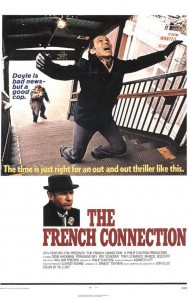 While it was in production, no one expected William Friedkin’s “The French Connection” to either become such a major critical and commercial hit or win the 1971 Best Picture Oscar. But it did, capturing additional Oscars for Director, Actor (Gene Hackman), Screenplay (Ernest Tidyman), and Editing (Jerry Greenberg).
While it was in production, no one expected William Friedkin’s “The French Connection” to either become such a major critical and commercial hit or win the 1971 Best Picture Oscar. But it did, capturing additional Oscars for Director, Actor (Gene Hackman), Screenplay (Ernest Tidyman), and Editing (Jerry Greenberg).The importance of “French Connection” could not be overestimated. The legitimized the film’s status as one of the best “cop and caper” films of the decade. The film contributed, as scholar James Monaco observed, to the brief resurgence of film noirs in the 1970s, and was also trendsetter in its visual style and visceral excitement. “The French Connection” made the cop film the most popular and the most distinctive genre of the decade, preceding the release of Clint Eastwood’s first “Dirty Harry,” which became a successful series, by a few months.
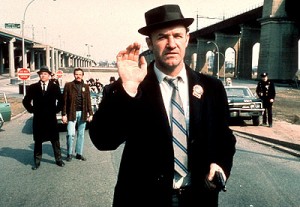 Every element in “The French Connection” is good in its own right, but becomes even better as part of the whole movie. The film has a sharp screenplay, based on the two real-life policemen, Eddie Egan and Sonny Grosso (who served as technical advisers for the film and also appeared in minor roles), who were involved in tracking down a large shipment of pure heroin hidden in a car transported from Marseilles to New York City.
Every element in “The French Connection” is good in its own right, but becomes even better as part of the whole movie. The film has a sharp screenplay, based on the two real-life policemen, Eddie Egan and Sonny Grosso (who served as technical advisers for the film and also appeared in minor roles), who were involved in tracking down a large shipment of pure heroin hidden in a car transported from Marseilles to New York City.
In addition to being a suspenseful, containing one of the best chase scenes in American film, imitated since in many pictures, the tale revolves around an interesting and complex character. Popeye Doyle (Gene Hackman) is a tough, vulgar, bigotted cop, obsessed with breaking up the international narcotic ring. To think that the filmmakers considered other actors for the role (Jackie Gleason and Steve McQueen, among others) is hard to believe, for it provided Hackman with the best role of his career to date.
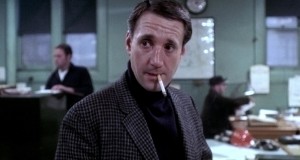 “The French Connection” also boasts breathtaking, ultra-realistic cinematography and sound track of the streets of New York, and well-paced editing, all of which contributed to a well-made, entertaining movie. Praised by most critics, “French Connection” went on to earn in domestic rentals $26 million dollars, ranking 3rd among the year’s top-grossing films.
“The French Connection” also boasts breathtaking, ultra-realistic cinematography and sound track of the streets of New York, and well-paced editing, all of which contributed to a well-made, entertaining movie. Praised by most critics, “French Connection” went on to earn in domestic rentals $26 million dollars, ranking 3rd among the year’s top-grossing films.
Synopsis
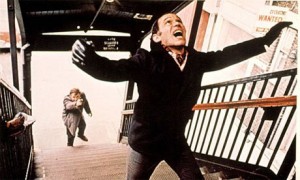 The tale begins in Marseilles, where Alain Charnier (Fernando Rey), a wealthy French criminal who runs a large heroin-smuggling syndicate, is followed by an undercover detective. The cop is assassinated by Charnier’s henchman, Pierre Nicoli (Marcel Bozzuffi). Charnier plans to smuggle $32 million worth of heroin into the U.S. by hiding it in the car of his friend, French TV personality Henri Devereaux (Frédéric de Pasquale).
The tale begins in Marseilles, where Alain Charnier (Fernando Rey), a wealthy French criminal who runs a large heroin-smuggling syndicate, is followed by an undercover detective. The cop is assassinated by Charnier’s henchman, Pierre Nicoli (Marcel Bozzuffi). Charnier plans to smuggle $32 million worth of heroin into the U.S. by hiding it in the car of his friend, French TV personality Henri Devereaux (Frédéric de Pasquale).
In New York, detectives Jimmy “Popeye” Doyle (Gene Hackman) and Buddy “Cloudy” Russo (Roy Scheider) conduct undercover stakeout in Bedford-Stuyvesan, Brooklyn. After seeing a drug transaction in a bar, the suspect escapes, while injuring Cloudy with a knife.
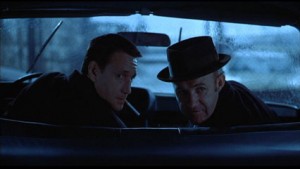 Popeye and Cloudy go out for drinks at the Copacabana, where Popeye notices Salvatore “Sal” Boca (Tony Lo Bianco) and his wife Angie (Arlene Farber) entertaining mob members involved in narcotics. Tailing the couple, they learn that the Bocas, who run a luncheonette, have criminal records: Sal for armed robbery and murder, and Angie for shoplifting. The detectives soon establish links between the Bocas and Joel Weinstock (Harold Gary), a lawyer with connections in narcotics underworld.
Popeye and Cloudy go out for drinks at the Copacabana, where Popeye notices Salvatore “Sal” Boca (Tony Lo Bianco) and his wife Angie (Arlene Farber) entertaining mob members involved in narcotics. Tailing the couple, they learn that the Bocas, who run a luncheonette, have criminal records: Sal for armed robbery and murder, and Angie for shoplifting. The detectives soon establish links between the Bocas and Joel Weinstock (Harold Gary), a lawyer with connections in narcotics underworld.
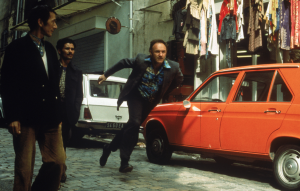 Popeye learns from an informant that a shipment of heroin will arrive in N.Y. The detectives convince their supervisor, Walt Simonson (Eddie Egan), to wiretap the Bocas’ phones Popeye and Cloudy are joined in the investigation by federal agent Mulderig (Bill Hickman). Popeye and Mulderig have a history workingd together in the past; Mulderig holds Popeye responsible for a cop’s death.
Popeye learns from an informant that a shipment of heroin will arrive in N.Y. The detectives convince their supervisor, Walt Simonson (Eddie Egan), to wiretap the Bocas’ phones Popeye and Cloudy are joined in the investigation by federal agent Mulderig (Bill Hickman). Popeye and Mulderig have a history workingd together in the past; Mulderig holds Popeye responsible for a cop’s death.
After Devereaux’s Lincoln Continental Mark III arrives in N.Y., Weinstock’s chemist (Pat McDermott) tests a sample of the heroin, establishing that the shipment could make $32 million on a small investment. Boca wants to move quickly, but Weinstock urges patience, knowing Boca’s phone is tapped.
Nicoli offers to kill Popeye, but Charnier objects, knowing that Popeye would be replaced by another policeman. Nicoli attempts to assassinate Popeye from the roof of his apartment but botches the job. Popeye chases the killer, who boards an elevated train at the Bay 50th Street Station in Bensonhurst. Doyle commandeers a car and chases along Stillwell Avenue. Nicoli hijacks the train, holds the driver at gunpoint, and kills a policeman. The train reaches the end of the line and slams into another train. When he sees Popeye, the killer runs but is shot dead by the detective.
Popeye impounds Devereaux’s Lincoln, taking it apart in search for the drugs. Cloudy notes that the vehicle’s weight is 120 pounds over its listed manufacturer’s weight, meaning the drugs are still in the car. They remove the panels and discover the drugs in the car’s body. The police restore the car to its original condition, and return it to Devereaux, who delivers the Lincoln to Charnier.
Charnier drives to an old factory on Wards Island to meet Weinstock. After Charnier has the rocker panels removed, Weinstock’s chemist tests one of the bags. Charnier removes the bags of drugs, and hides the money; concealing it beneath the rocker panels of another car purchased at an auction of junk cars. The transaction is complete, and Charnier and Sal drive off in the Lincoln, but they hit a roadblock with a police force led by Popeye, who waves to Charnier. The police chase the Lincoln back to the old factory, where Sal is killed during a shootout, and most of the others surrender.
Charnier escapes into the warehouse. When Popeye sees a shadowy figure in the distance, he empties his revolver a split-second after shouting a warning. The man whom Popeye kills, however, is Mulderig. . After reloading his gun, Popeye runs into another room, and a single gunshot is heard.
Sequel
Three years later, Fox made the sequel, “The French Connection II,” also starring Gene Hackman and Fernando Rey, but with a different director, John Frankenheimer, and crew. With the exception of a chase scene and a few other set-pieces, the movie is a disappointing follow-up.
Cast
Jimmy “Popeye” Doyle (Gene Hackman)
Alain Charnier (Fernando Rey)
Buddy Russo (Roy Schedier)
Sal Boca (Tony Lo Bianco)
Pierre Nicoli (Marcel Bozzufi)
Devereaux (Frederic de Pasquale)
Mulderig (Bill Hackman)
Marie Charnier (Ann Rebbot)
Weinstock (Harold Gary)
Klein (Sonny Grosso)
Running time: 104 Minutes










